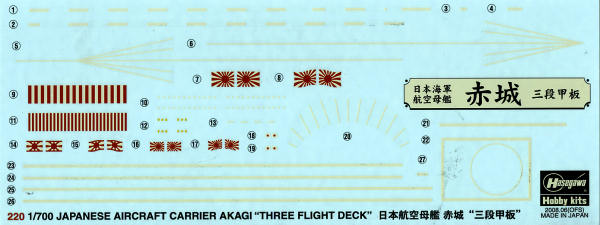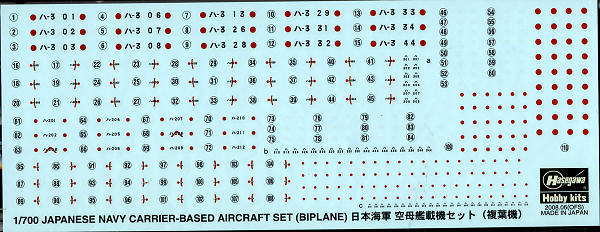
Hasegawa 1/700 IJN Akagi "Three Flight Deck"
| KIT #: | 43220 |
| PRICE: | $53.00 MSRP |
| DECALS: | Two options |
| REVIEWER: | Carmel J. Attard |
| NOTES: | New mold with 12 aircraft. |

| HISTORY |
Akagi was laid down as an Amagi class battlecruiser at Kure, Japan. However, the Washington Naval Treaty, which Japan signed in 1922, prevented Japan from completing Akagi. Because the Treaty authorized conversion of two battleship or battlecruiser hulls into aircraft carriers of up to 33,000 tons displacement, the incomplete hulls of Amagi and Akagi were selected for completion as carriers.
Amagi's hull was damaged beyond economic repair in the Great Kantō earthquake of 1 September 1923. The remaining battlecruisers of the class, Atago and Takao were cancelled and scrapped in 1924, in accordance with the terms of the Washington Naval Treaty.
Akagi, the only remaining member of her class, was launched on 22 April 1925 and completed at Kure Naval Arsenal on 27 March 1927. As completed, the ship had two hangar decks with a capacity of 61 aircraft. The hangars opened onto two superimposed flying off decks at the bow. In theory, this permitted aircraft to take off directly from the hangars, while landing on the main flight deck above. Funnel gasses were discharged through a downturned starboard funnel. To compensate for the weight of the hangar structure, the horizontal armor was reduced from 3.8 to 3.1 inches and moved one deck lower. The belt armor was reduced from 10 to 6 inches and was also lowered by one deck.
In practice, the multiple flight deck arrangement proved unsuccessful. From 1935 to 1938, Akagi received a massive reconstruction at Sasebo Naval Arsenal. It extended the hangars forward, removed the flying off decks, and increased aircraft capacity to 91. The refit added an island superstructure on the port side of the ship, which was an unusual arrangement; the only other carrier to share this feature was a contemporary, the Hiryū. Akagi and the Hiryū were intended to work in a tactical formation with starboard-sided carriers, in order to improve the flight pattern around the formation, but the experiment was not continued beyond those two carriers.
Because Akagi was initially conceived as a battlecruiser, the prevailing ship naming conventions dictated that she (like her sister ships) be named after a mountain. Akagi was named after Mount Akagi, a dormant volcano in the Kantō region (the name literally means "red castle"). After she was redesignated as an aircraft carrier her mountain name remained, in contrast to bespoke aircraft carriers like Sōryū, which were named after flying creatures. The name was previously given to the Maya class gunboat Akagi.
| THE KIT |
1/700 waterline ship fans will be delighted with this new mold kit from Hasegawa. 'Tween wars ships are not all that common outside the very expensive realm of resin ship kits, and to my knowledge, this is the first time the early Akagi has been kitted.

As one might expect, there are hundreds of small parts to this one, a number of those bits making up the 12 aircraft that are supplied. Due to the sheer size of the sprues, I've posted the drawing of the sprues layout so you can get an idea of what to expect. The plastic is superbly molded and inspection turned up no flash or other molding flaws. Even the relatively thick ship's boats had no sink areas and ejector pin markings were limited to areas that will be covered up after construction.
 The main hull is split in two halves with the flat waterline section helping to stiffen things. Unusually, this is not cast in red plastic as on their other waterline kits. Braces are provided as on their larger 1/350 ships to keep things from being out of line. Of course, a hefty weight is supplied as well. The kit can be built as either the early 1927-34 version or the 'middle' 1934-35 ship prior to her entering massive rebuild. The differences are actually quite minor and most would not notice any changes between the two. Elevators are separate, but really, there is little in the way of hangar bay detailing so most will probably cement them flush with the main deck.
The main hull is split in two halves with the flat waterline section helping to stiffen things. Unusually, this is not cast in red plastic as on their other waterline kits. Braces are provided as on their larger 1/350 ships to keep things from being out of line. Of course, a hefty weight is supplied as well. The kit can be built as either the early 1927-34 version or the 'middle' 1934-35 ship prior to her entering massive rebuild. The differences are actually quite minor and most would not notice any changes between the two. Elevators are separate, but really, there is little in the way of hangar bay detailing so most will probably cement them flush with the main deck.
 Instructions are a large fold out sheet with the usual Gunze paint references. Any differences between build 1 or 2 are clearly noted and since holes have to be punched out for one or the other, a decision needs to be made early as to which to do. There are two main decal sheets and these appear to be 'old style' with somewhat off white whites. They are quite glossy. One sheet is for the ship and includes the various flight deck markings, so no need to paint those. The other is for the aircraft and provide markings for what looks like 30 different aircraft (15 type 90 fighters and 15 type 13 torpedo bombers), even though only six of each are supplied. Building the aircraft on this one will be a construction job in and of itself, thanks to all the tiny decals.
Instructions are a large fold out sheet with the usual Gunze paint references. Any differences between build 1 or 2 are clearly noted and since holes have to be punched out for one or the other, a decision needs to be made early as to which to do. There are two main decal sheets and these appear to be 'old style' with somewhat off white whites. They are quite glossy. One sheet is for the ship and includes the various flight deck markings, so no need to paint those. The other is for the aircraft and provide markings for what looks like 30 different aircraft (15 type 90 fighters and 15 type 13 torpedo bombers), even though only six of each are supplied. Building the aircraft on this one will be a construction job in and of itself, thanks to all the tiny decals.
| CONCLUSIONS |
I'll not delve into the MSRP as one can get this for less, but it is a superbly molded kit with lots of parts so in many ways is worth what you will pay for it. I can guarantee it will provide hours of modeling pleasure.
September 2008
If you would like your product reviewed fairly and fairly quickly, please contact the editor or see other details in the Note to Contributors.